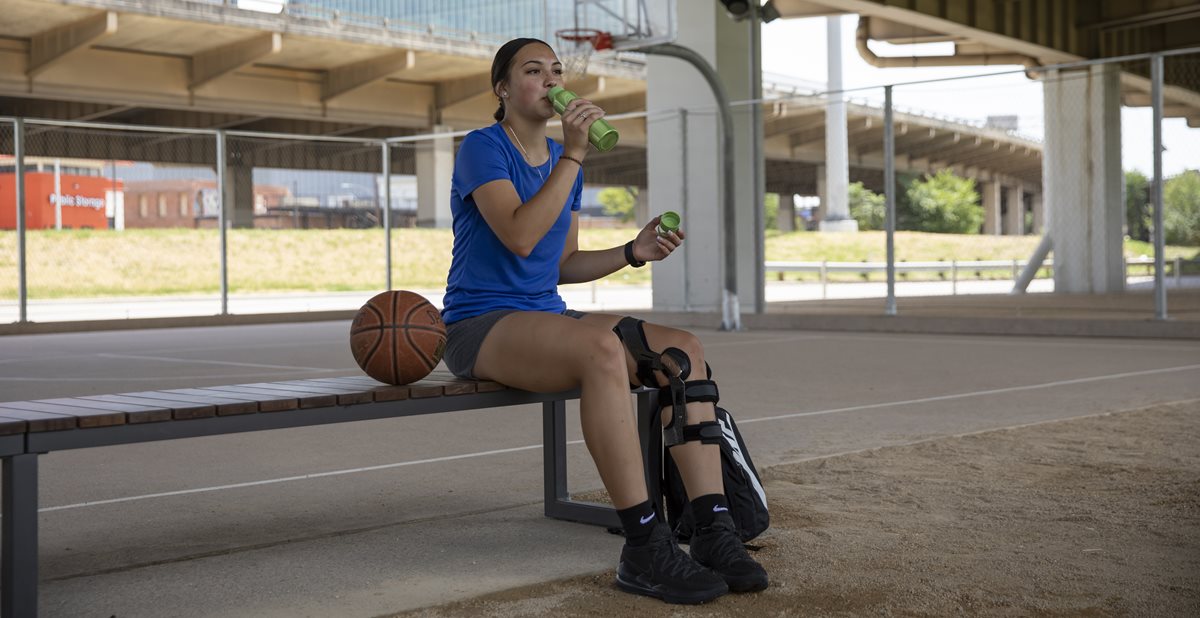
Apr 15, 2021 / Sports Medicine
Getting Stronger: A Pediatric Perspective on Resistance Training
This article was originally published in a 2021 newsletter for the Pediatric Society of Greater Dallas. Written by sports medicine physician Jacob C. Jones, M.D, RMSK.
Print the PDF
There are many opinions surrounding resistance training in youth. Some worry about the risks of injuries and negative effects on growth plates, while others see value in gaining a physical advantage over the competition. Some providers are so concerned that they may feel most comfortable recommending youth not participating in resistance training. However, as we navigate the extremes of the day, the professionalization of youth sports and alarming rates of childhood obesity and inactivity, we must consider the pros and cons, and the safest approaches.
What is resistance training?
For some, resistance training has a narrow definition and requires lifting weights. Yes, lifting weights with proper technique can improve strength. However, equipment is not necessary to improve strength for most children. Other creative ways include active movements using body weight. There are fun ways for young kids to work on strength that mimic different types of animals which are used by some physical education teachers. These include doing “crab walks,” “bear crawls,” and “kangaroo hops.” These activities properly focus on coordination, developing core strength and learning proper form before adding weight.
What should youth expect from resistance training?
Resistance training has many health benefits. Yes, it does improve strength, but not in the way that we typically think of. Before youth develop high levels of endogenous androgens, strength is improved by increasing neuromuscular activation and not due to muscular hypertrophy. Much to the chagrin of some youth, improving strength will not produce a generation of pre-pubescent Arnold Schwarzeneggers. Other noticeable benefits include improvements in speed, muscle endurance, proprioception and motor skills.
Strength gains in youth can reduce the risk of injury. As muscles activate properly and eventually grow, they will bear the burden of increased activity instead of ligaments, tendons, and bones. Specifically, muscle gains have shown to reduce the incidence of ligament tears, stress fractures, and tendon irritations among others. Additionally, when injuries do occur, those with resistance training experience rehabilitate more quickly and effectively.
When can youth begin safely lifting weights?
There is not a specific age when weightlifting may begin. We provide the recommendation more upon the individual’s experience with resistance training than the actual chronological age. Youth must first possess the capacity and maturity to follow directions. Then, they should focus on using proper technique with body weights alone. Once mastered, with proper supervision youth can advance to lifting weights with simple movements before progressing to more complex. Typically, youth begin doing 1-2 sets of 8-12 repetitions using low resistance, 2-3 times per week, and then are gradually advanced. Set expectations with these youth that strength gains will be gradual and trying to rush them will lead to injuries. Current research is clear - adolescents using proper technique with certified supervision can gain strength without putting growth plates at risk! Overall injury rates are very low.
How do the benefits extend beyond the musculoskeletal system?
As the medical community continues to combat childhood obesity, resistance training offers a means to offset many of the adverse effects. Physical benefits include improvements to cardiovascular health, bone density, cholesterol levels and insulin sensitivity. Mental health benefits include a reduction in symptoms of anxiety and depression while improving self-confidence, memory and creativity.
How does this fit into a physical activity plan already in place?
The Center for Disease Control (CDC) recommends that kids get 60 minutes of moderate to vigorous physical activity (MVPA) daily. To avoid overtraining, the American Academy of Pediatrics (AAP) recommends 1-2 days off from competitive athletics, sport-specific training and sports practice per week. We want kids to be active daily, but they do need to take breaks from competition and repetitive movements that can cause overuse injuries. With any activity or exercise program, youth should maintain adequate hydration and fuel with appropriate nutrition to meet the demands of activity and growth.
As opposed to the overtraining athlete, youth that do not exercise at the recommended levels are thought to have a condition called exercise deficit disorder (EDD). Like other healthy habits, if exercise is not integrated in early years, it is more challenging to do later in life. Cardiovascular fitness remains vital especially during the decades-long pandemic of childhood obesity. Getting more sedentary kids motivated to move can be difficult. Each kid has different interests, and resistance training may provide an initial steppingstone for a more active lifestyle. Strength training does improve overall activity, but it can actually lead to increased aerobic activity, too! Hearing someone say, “Let’s run some laps!” or even the word “exercise” can be a dreaded moment for many, but perhaps resistance training can be a gateway to making these experiences more favorable.
Few contraindications exist for resistance training. These include uncontrolled hypertension, certain heart conditions, uncontrolled seizures and a history of treatment with anthracycline chemotherapy.
What can we do?
There is a large gap between what evidence-based studies have taught us and what our patients actually do. Here are a few things to remember:
Print the PDF
There are many opinions surrounding resistance training in youth. Some worry about the risks of injuries and negative effects on growth plates, while others see value in gaining a physical advantage over the competition. Some providers are so concerned that they may feel most comfortable recommending youth not participating in resistance training. However, as we navigate the extremes of the day, the professionalization of youth sports and alarming rates of childhood obesity and inactivity, we must consider the pros and cons, and the safest approaches.
What is resistance training?
For some, resistance training has a narrow definition and requires lifting weights. Yes, lifting weights with proper technique can improve strength. However, equipment is not necessary to improve strength for most children. Other creative ways include active movements using body weight. There are fun ways for young kids to work on strength that mimic different types of animals which are used by some physical education teachers. These include doing “crab walks,” “bear crawls,” and “kangaroo hops.” These activities properly focus on coordination, developing core strength and learning proper form before adding weight.
What should youth expect from resistance training?
Resistance training has many health benefits. Yes, it does improve strength, but not in the way that we typically think of. Before youth develop high levels of endogenous androgens, strength is improved by increasing neuromuscular activation and not due to muscular hypertrophy. Much to the chagrin of some youth, improving strength will not produce a generation of pre-pubescent Arnold Schwarzeneggers. Other noticeable benefits include improvements in speed, muscle endurance, proprioception and motor skills.
Strength gains in youth can reduce the risk of injury. As muscles activate properly and eventually grow, they will bear the burden of increased activity instead of ligaments, tendons, and bones. Specifically, muscle gains have shown to reduce the incidence of ligament tears, stress fractures, and tendon irritations among others. Additionally, when injuries do occur, those with resistance training experience rehabilitate more quickly and effectively.
When can youth begin safely lifting weights?
There is not a specific age when weightlifting may begin. We provide the recommendation more upon the individual’s experience with resistance training than the actual chronological age. Youth must first possess the capacity and maturity to follow directions. Then, they should focus on using proper technique with body weights alone. Once mastered, with proper supervision youth can advance to lifting weights with simple movements before progressing to more complex. Typically, youth begin doing 1-2 sets of 8-12 repetitions using low resistance, 2-3 times per week, and then are gradually advanced. Set expectations with these youth that strength gains will be gradual and trying to rush them will lead to injuries. Current research is clear - adolescents using proper technique with certified supervision can gain strength without putting growth plates at risk! Overall injury rates are very low.
How do the benefits extend beyond the musculoskeletal system?
As the medical community continues to combat childhood obesity, resistance training offers a means to offset many of the adverse effects. Physical benefits include improvements to cardiovascular health, bone density, cholesterol levels and insulin sensitivity. Mental health benefits include a reduction in symptoms of anxiety and depression while improving self-confidence, memory and creativity.
How does this fit into a physical activity plan already in place?
The Center for Disease Control (CDC) recommends that kids get 60 minutes of moderate to vigorous physical activity (MVPA) daily. To avoid overtraining, the American Academy of Pediatrics (AAP) recommends 1-2 days off from competitive athletics, sport-specific training and sports practice per week. We want kids to be active daily, but they do need to take breaks from competition and repetitive movements that can cause overuse injuries. With any activity or exercise program, youth should maintain adequate hydration and fuel with appropriate nutrition to meet the demands of activity and growth.
As opposed to the overtraining athlete, youth that do not exercise at the recommended levels are thought to have a condition called exercise deficit disorder (EDD). Like other healthy habits, if exercise is not integrated in early years, it is more challenging to do later in life. Cardiovascular fitness remains vital especially during the decades-long pandemic of childhood obesity. Getting more sedentary kids motivated to move can be difficult. Each kid has different interests, and resistance training may provide an initial steppingstone for a more active lifestyle. Strength training does improve overall activity, but it can actually lead to increased aerobic activity, too! Hearing someone say, “Let’s run some laps!” or even the word “exercise” can be a dreaded moment for many, but perhaps resistance training can be a gateway to making these experiences more favorable.
Few contraindications exist for resistance training. These include uncontrolled hypertension, certain heart conditions, uncontrolled seizures and a history of treatment with anthracycline chemotherapy.
What can we do?
There is a large gap between what evidence-based studies have taught us and what our patients actually do. Here are a few things to remember:
- Encourage kids to do it! Age-appropriate resistance training activities can be done anywhere and at any age, without any special equipment needed.
- Youth should focus on body movements and body weight resistance activities before advancing to actual weightlifting. Emphasize that any weightlifting should be done with adequate instruction and supervision to ensure proper technique.
- Remind youth and parents that injuries occur with inappropriate goals and techniques. For example, lifting maximum weight with ballistic maneuvers has a high risk of injury. Look for coaches or specialists with appropriate certification in strength training. A common certification is Certified Strength and Conditioning Specialist (CSCS). Others include High School Strength and Conditioning Specialist (HSSCS), Youth Exercise Specialization (YES), or Performance Enhancement Specialist (PES).
- Remember that resistance training can promote activity in otherwise inactive youth. This can lead to an overall healthier lifestyle well beyond muscle strength and endurance.



